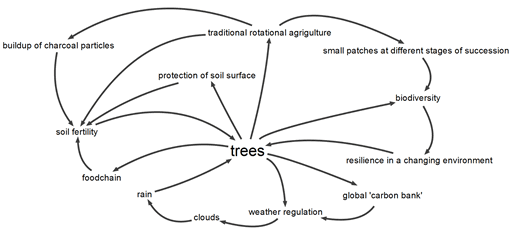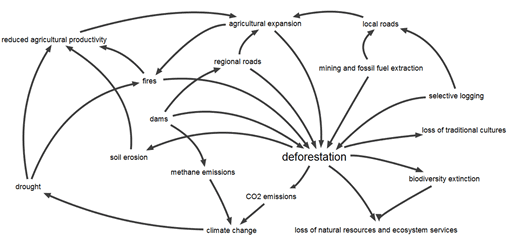The Amazon System
A system isn’t just a collection of parts - system components work together in order to enhance the overall survival of the system as a whole. The various components of the Amazon System – the trees, the rivers, the wildlife and the traditional communities – work together to create a highly dynamic, rich and resilient system which has survived for thousands of years. This has created a distinctive social and ecological entity: the Amazon rainforest and its associated indigenous and other communities undertaking traditional land use practices.
The role played by the trees of the Amazon

At the centre of the Amazon system are its billions of trees. These trees generate the climate which allows the recycling of water, brought in as moisture from the Atlantic Ocean and Caribbean Sea, to reach mountain tops many thousands of kilometres inland. They protect the fragile soils from the torrential tropical downpours, and provide food for the incredible biodiversity and the communities that live within the rainforest. By removing the trees, a tipping point may be reached where the whole system could collapse, with serious global implications.
Communities
It is also clear that communities engaging in traditional land use practices are an integral part of the Amazon system. There is now conclusive evidence that thousands of years of indigenous rotational farming within the Amazon has actually created vast areas of charcoal rich dark soil – the ‘terra preta’ - which has enhanced the productivity and biodiversity of the Amazon ecosystem (some researchers have estimated that parts of the Amazon region were occupied by millions of indigenous people before the ‘discovery’ of the ‘New World’ by Europeans which brought in disease and slavery, resulting in their decimation and current low densities). Traditional management sustains and enhances the Amazon’s ecology.
The Amazon’s natural resources
The Amazon is the location of vast natural resources: from mineral ores (iron, aluminium, manganese, uranium, copper, gypsum, nickel and gold), fossil fuel reserves (petroleum, gas and lignite), renewable energy potential (through hydroelectric dams), timber and agricultural land. Minerals, fossil fuels, electricity, wood and food are the ‘natural resources’ which we all use and consume every day. With a growing global population and ever increasing rates of consumption per capita, these commodities are becoming scarce and highly sought after.
Use of resources to improve living standards
The countries controlling the Amazon – Brazil, Bolivia, Ecuador, Peru, Colombia, Venezuela, Guyana , Suriname and French Guiana (an overseas territory of France) – are totally justified in their push to achieve the same standard of living of developed countries, such as the US and the UK. Whatever the metrics, Amazon countries still have a long way to go. Making use of the vast natural resources present in the Amazon is seen as playing an important part in the development process. However, much of the development which has taken place so far has been badly planned and poorly executed. During the last half century, the seemingly endless Amazon has lost large areas of forest cover, its connectivity has been disrupted, and the vast majority of the people living in the Amazon are confronted with abject poverty, primitive public services and severe health problems. On the other hand, a small number of elite individuals and their associated corporations have significantly benefited from the exploitation of the Amazon’s natural resources.
The economic transformation of the Amazon based on the conversion and degradation of its natural ecosystem – its forests – is gaining momentum (see the interactive map from the University of Maryland).
Yet, there are also many examples of the sustainable exploitation of the Amazon’s natural resources alongside the protection of its biological and cultural diversity.
A complex situation
The situation in the Amazon is complex due to:
- the many conflicting interest groups involved from every level of organisation (international and national policymakers, researchers and NGOs, regional institutions, and local stakeholders, including settlers, loggers, ranchers, Coca-farmers, miners and indigenous communities)
- the ecological dynamics of the Amazon being poorly understood; the impacts of various interventions being difficult to predict
- the increasing pressures to both exploit the natural resources present in the Amazon (hardwood, minerals, hydroelectricity) and protect its cultural and biological diversity.
It is clear that the survival of the Amazon itself is at stake.
The challenges
With limited resources, you have to pick your battles carefully. Given the many dynamics at play in a region as enormous as the Amazon, an effort has been made to identify the human-induced processes which have the greatest impact on the region as a whole. The diagram shows a cause-and-effect diagram of the direct threats contributing to the Amazon’s ecological and cultural degradation.
Our task is to identify how these challenges interact with each other and affect the six 'survival strategies' of the Amazon socio-ecological system: existence; resistance; efficiency; flexibility; adaptability; and coexistences.

Next: Amazonian challenges: Cattle ranching and agriculture
This page is part of our series of articles on the Amazon System, emerging out of the experience of Dr Andrea Berardi, a Lecturer in Environmental Information Systems at The Open University to support the BBC Two series I Bought a Rainforest. See the full reference list for these articles.
Dr Berardi is a co-investigator on Project COBRA. COBRA is researching ways to integrate community solutions within policies addressing escalating social, economic and environmental crises, through accessible information and communication technologies.
Rate and Review
Rate this article
Review this article
Log into OpenLearn to leave reviews and join in the conversation.
Article reviews